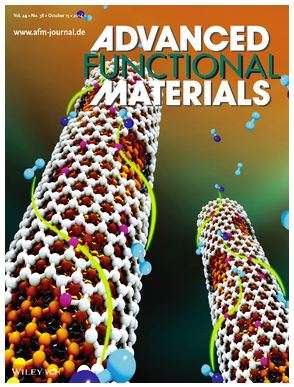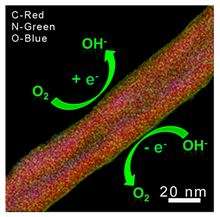Toward full exposure of 'active sites' for coaxial nanocables

Catalysts are of paramount importance to achieve high efficiency and economic profit for most heterogeneous reactions. Since catalytic reaction occurs only when reactants reach the active sites, these active sites must be maximally exposed at the surface in a high efficiency catalyst.
Based on this consideration, researchers from Tsinghua University in China have now demonstrated a unique coaxial carbon nanocable material with pristine carbon nanotube (CNT) as the core and a nitrogen-doped wrinkled carbon layer as the shell. The coaxial nanocables, denoted as CNT@NCNT, are enriched with N dopant atoms at the surface—that is, the N-incorporation induced active sites are exposed at the surface. The team reported their research in Advanced Functional Materials, issue 38, volume 24.
"Carbon nanotubes, a super-star functional material, have attracted much attention since they were found in 1991. Moreover, the incorporation of hetero-atoms into the CNT skeleton renders the doped CNTs with improved chemical reactivity and sequentially good catalytic performance." Dr. Qiang Zhang told Phys.Org, "For most of N-doped CNTs (NCNTs) directly synthesized by chemical vapor deposition growth and chemical doping, the incorporated N atoms distribute uniformly. Therefore, the active sites induced by the dopant atoms in the inner walls are hardly accessible and consequently contributed to the catalytic activity scarcely."
"Besides, the bamboo-like structure or the cup-stacked structure of the routine NCNTs renders complex packing of graphene layers, which hinders the rapid electron transport along the graphene layers. Consequently, it's highly desired for an efficient NCNT electrocatalyst to incorporate N atoms into carbon nanotubes selectively on the surface to fully expose the active sites while the inner continuous CNT walls are well preserved."
In this regard, Gui-Li Tian, a graduate student and the first author of the paper, developed a facile, non-liquid phase method to fabricate the CNT@NCNT coaxial nanocables. "A thin N-containing turbostratic carbon layer can epitaxially grow on the outer walls of pristine CNTs by CVD of N-containing compounds, resulting in the coaxial nanocables constituted by the cylindrical CNT walls and the wrinkled N-doped layers," says Tian. "The dopant N atoms are enriched at the surface of the as-fabricated nanocables. And the inner walls remained intact as expected, leading to a high electrical conductivity of 3.3 S cm-1. Combining both the merits of surface-enriched dopant N atoms and continuous inner walls, CNT@NCNT possesses superior electrocatalytic activity. "

"Compared with the routine bulk-doped NCNTs at similar doping level, the CNT@NCNT catalyst afforded higher current density and lower overpotential both for oxygen reduction and evolution reaction."
Prof. Fei Wei added, "The incorporated N atoms are concentrated at the surface of CNT@NCNT. Therefore, the active sites induced by the doping atoms are more accessible to reactants. Furthermore, the polarity and hydrophily of the carbon material are also improved, which facilitated mass transfer at the interface between electrode material and electrolyte. In addition, high electrical conductivity attributed to the intact inner walls benefit rapid charge transfer from the N-doped layers into the CNT scaffolds. As a result, CNT@NCNT affords superior electrocatalytic performance in comparison with routine NCNTs."
"In addition to superior catalysts for oxygen electrochemistry, CNT@NCNT coaxial nanocables are also a good platform for full exposure of active sites for robust interfaces of high-performance composites, as well as efficient catalysts and/or metal nanoparticle supports for selective oxidation reaction and biosensors, etc." said Prof. Dang-Sheng Su from Institute of Metal Research, Chinese Academy of Sciences, at Shenyang, China, a co-author of the paper.
Since the surface hetero-junction nanostructures are not limited to CNTs, the researchers foresee a new branch of chemistry evolving in the area of full exposure of active sites through the 3D heterogeneous systems.
More information: Tian GL, Zhang Q, Zhang BS, Jin YG, Huang JQ, Su DS, Wei F. "Toward Full Exposure of 'Active Sites': Nanocarbon Electrocatalyst with Surface Enriched Nitrogen for Superior Oxygen Reduction and Evolution Reactivity." Advanced Functional Materials 2014, 24(38), 5956-5961. DOI: 10.1002/adfm.201401264
Journal information: Advanced Functional Materials
Provided by Tsinghua University


















